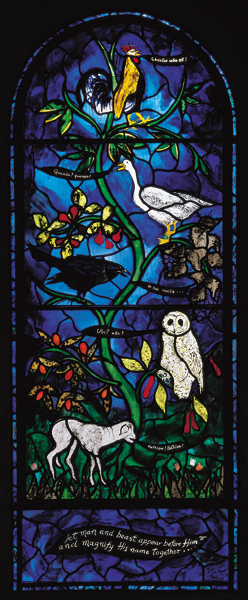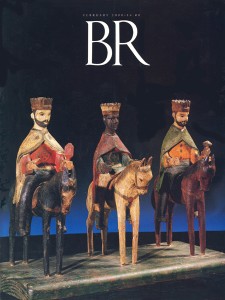
With God, the Gospels tell us, all things are possible (Matthew 19:26 etc.). To the medieval mind, the realm of possibility included Latin-speaking animals, who pronounced the arrival of the baby Jesus on Christmas day. In the Middle Ages, special masses featured choristers portraying animals gifted—if only for a day—with the power of human speech. This legend is thought to have sprung from the mind of the fourth-century hymn writer Prudentius, who composed a poem on the subject.
Twentieth-century British artist John Piper has captured such an event in stained glass for the Church of St. Mary’s in Iffley, England. From the highest branches of a tree, a rooster heralds both the coming of dawn and of Jesus: “Christus natus est—Christ is born!” A duck asks “Quando? Quando?—When? When?” “Ubi? Ubi?—“Where? Where?” an owl hoots. “Bethlem! Bethlem!” replies the lamb. (Apparently, this latter question—the subject of Where was Jesus Born? in this issue—was not a source of confusion for the animals.)
Similarly, creatures great and small twitter with comment and praise in “The Animals’ Carol,” by contemporary British poet Charles Causley:
Christus natus est! The cock
Carols on the morning dark.
Quando? croaks the raven stiff
Freezing on the broken cliff.
Hoc nocte, replies the crow
Beating high above the snow.
Ubi? Ubi? booms the ox
From its cavern in the rocks.
Bethlehem, then bleats the sheep
Huddled on the winter steep.
Already a library member? Log in here.
Institution user? Log in with your IP address.

